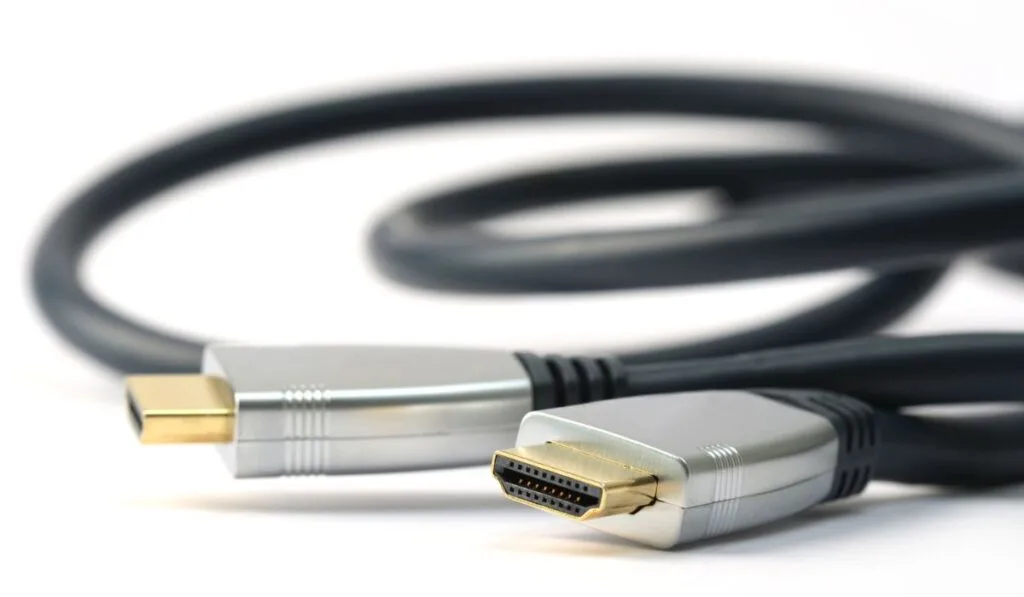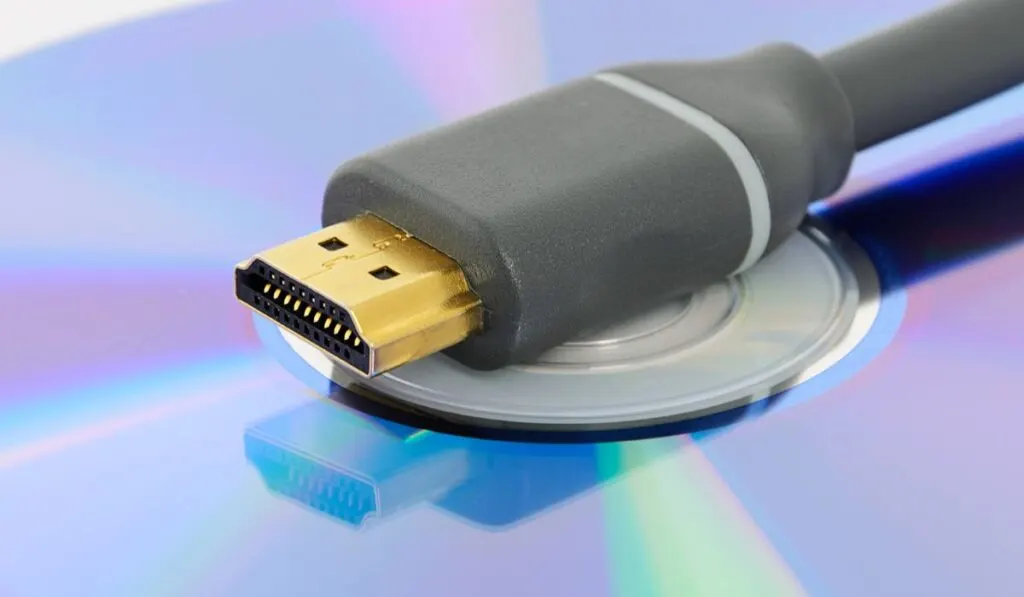When it comes to outputting video and audio from your device to a monitor, there are currently two kings on the market: HDMI and DisplayPort. But which one is the better option? When making a computer, should you prioritize HDMI or DisplayPort?
DisplayPort connections output at a higher resolution than HDMI. However, HDMI outputs at a higher framerate than DisplayPort. HDMI is also compatible with more devices than DisplayPort. Devices that use HDMI are also typically cheaper than DisplayPort devices.
The debate between DisplayPort and HDMI can get confusing, and it can be challenging to determine which port is the better option. So let’s discuss this debate in more detail to help you pick the correct video output for your device.
Which is Better: DisplayPort or HDMI?

When it comes to the debate between DisplayPort and HDMI cables (both examples on Amazon), there is not a clear winner. For example, DisplayPort outputs have a much higher potential resolution than HDMI outputs. However, HDMI outputs have a much higher potential framerate than DisplayPort outputs.
Since the debate between the two options isn’t that simple, we will need to gather some vital information first to determine which port is the right one for you—starting with what the terms “DisplayPort” and “HDMI” even mean.
What is DisplayPort?
DisplayPort is a kind of audio and video output that is becoming increasingly common with computers in modern times. DisplayPort is not nearly as popular or as common on the market as standard HDMI. However, many users think DisplayPort may be the superior option to HDMI.
How it Works
DisplayPort works just like any other audio and video output cable. You plug one side into the device from which you’re trying to output audio and video, and you plug the other side into a TV or monitor with a DisplayPort slot.
This should cause your monitor to automatically configure your settings, although, for some monitors, you may need to set your desired resolution and refresh rate manually.
Another great feature of DisplayPort is it can move audio and video. Back before the HDMI cable, a cable known as the VGA cable reigned supreme.
This cable could only transfer visual data and not audio data, meaning that every time you use a VGA cable to set up a display, you would also need to set up a separate audio cable.
DisplayPort works by using packetized data transmission. The cord transmits packets of data that have been embedded with something called a clock signal. This clock signal allows for a much more efficient stream of data transfer, allowing your monitor to have a much higher resolution and refresh rate.
When Should I Choose DisplayPort?
To sum it all up into one general statement: you should choose DisplayPort if it’s an available option that you can comfortably afford. Unfortunately, on many devices, DisplayPort may not be an available option.
One of the best reasons to switch to DisplayPort is for gaming. DisplayPort’s higher refresh rate and higher resolution support allow for much better-looking games with a much more immersive experience. However, this is only an option for PC gaming.
Unfortunately, all modern game consoles still use HDMI over DisplayPort. This includes the Xbox Series X, the Playstation 5, and the Nintendo Switch.
So if you want to stick to gaming on a dedicated gaming console, you will likely use HDMI rather than DisplayPort.
Nintendo, Sony, and Xbox have never stated why their consoles use HDMI instead of DisplayPort. However, the most prominent theory is that they use HDMI due to its broader use in TVs.
Although DisplayPort is becoming more popular with computer monitors, most modern TVs still exclusively feature the HDMI port. In addition, game consoles are mainly designed to be played on TVs, so most game consoles will likely use the same video ports available on most TVs.
Computer Monitors
Even though we’ve emphasized it so far, DisplayPort is not only for entertainment purposes. You can also set up one computer with more than one monitor using a single DisplayPort slot on the computer.
DisplayPort 1.2 and newer allows for a feature called daisy-chaining. Most DisplayPort monitors have a DisplayPort input slot and a DisplayPort output slot.
So if you plug your computer into the input slot on the monitor, you can plug another monitor into the original monitor via the output slot.
Using this method, you can plug your computer into as many monitors as you have DisplayPort cords. This makes DisplayPort extremely helpful for office work as you can have as much screen space as you need.
What is HDMI?

The HDMI cable, or the High Definition Multimedia Interface cable, is another form of video and audio output cable. It is also one of the market’s most popular video and audio output cables. But why is the HDMI cable the more popular option?
Why it Was Created
HDMI initially replaced the VGA cable, the most popular option before HDMI. The VGA cable had some problems, mainly its maximum resolution output and its lack of audio capability.
The VGA cable only provides a maximum resolution of 640 x 480 with a refresh rate of 60 Hz. Meanwhile, the HDMI 2.1 cord offers a maximum resolution of 3840 x 2160 (commonly referred to as 4K UHD) with a refresh rate of 120 Hz. Looking at these numbers, you can already tell the HDMI cord is vastly superior to the VGA cable.
The HDMI cable didn’t just defeat the VGA cable in terms of performance. It also defeated it in terms of convenience. Not only is the HDMI cable smaller than the VGA cable, but it also contains audio capabilities.
The VGA cable could not transfer audio data. So for every monitor or TV, you set up with VGA, you need to plug in two cords: a VGA cable for display and a separate audio jack. The HDMI cable having audio capability cleaned up the cable situation behind every monitor you own, making it much easier to figure out how to plug in your devices.
Why it’s More Popular
HDMI defeated DisplayPort in popularity for one simple reason: it was made first. The original HDMI 1.0 cable was released on December 9th, 2002, while the original DisplayPort wouldn’t debut until 2006.
This meant many devices (such as HD DVD players, HD TVs, and Blu-Ray players) started using HDMI ports entirely because that’s what they had to work with. Since then, HDMI has reigned supreme as the world’s audio and visual output entirely through the mindset of “If it isn’t broken, don’t fix it.”
When Should I Choose HDMI?

The main reason you would want to choose HDMI over DisplayPort is for compatibility. As we mentioned before, most devices made today still use HDMI, meaning that if you want your device to be compatible with most devices, you’ll need HDMI capability.
For example, most TVs rely entirely on HDMI capability to connect to them. So if you want your computer to connect to a TV, you will need to have at least one HDMI port on your computer.
For this reason, most prebuilt computers already come with at least one HDMI port, meaning if you’re planning on buying a prebuilt computer, this decision has likely already been made for you.
But while DisplayPort has a higher maximum resolution and higher refresh rates than the HDMI cable, HDMI’s resolution and refresh rates are still awe-inspiring.
The modern HDMI 2.0 cable can support a 4K resolution at a 60Hz refresh rate. The more advanced HDMI 2.1 supports up to 10K resolution at a 120Hz refresh rate. However, for most consumers, 4K is all they desire, so supporting 10K resolution is already overkill.
Advantages and Disadvantages of Both
So after considering all of the factors that go into HDMI and DisplayPort, we finally reach the central question of the night: which one is better? The answer to that question is, unfortunately, not that simple. So first, we must consider both options’ advantages and disadvantages.
Resolution
First off, DisplayPort has higher resolution support than HDMI. For instance, a DisplayPort 2.0 can reach a maximum resolution of 16K with HDR. In contrast, the newest HDMI 2.1 only supports up to 10K resolution, meaning that your monitor’s display will look better with a DisplayPort.
However, DisplayPort sacrifices a bit of the refresh rate for this higher resolution. DisplayPort’s maximum 16K resolution comes with a refresh rate of 60Hz, while HDMI’s 10K has a refresh rate of 120Hz.
The natural question is, “What if you use a 10K resolution with a DisplayPort? Does this raise the refresh rate?” The answer to this question is yes, but still not to the levels of HDMI.
A DisplayPort 2.0 running at 10K will only reach a refresh rate of 80Hz, significantly less than the HDMI 2.1’s 120Hz. The refresh rate controls your computer’s framerate, meaning that your computer will run at a lower framerate with a DisplayPort than an HDMI input.
Compatibility
Another category that HDMI defeats DisplayPort is compatibility. There are way more devices that are made to be compatible with HDMI than DisplayPort, including modern TVs, game consoles, Blu-Ray players, and more.
Therefore, if you want your computer to be compatible with any of these devices, you will need at least one HDMI port.
Price
Finally, price is one of the most important aspects to consider in any product debate. Due to its higher resolution specs, devices that feature DisplayPort outputs are more expensive on average than devices with HDMI outputs.
In Conclusion
If you value higher resolutions above all else, the DisplayPort is an audio and video output you should consider.
However, if you’re trying to stay under a budget or value things like compatibility and framerate, you may want to stick with HDMI.
